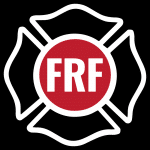Foam Rolling for Better Fitness
People tend to measure how effectively they’ve worked out by how sore they are the following days. Let me ask you: How good is a workout that leaves you so sore that you can’t workout for the next 3 days? What most people don’t realize is that your body improves and adapts to stress on the days you rest. The better and more rapidly you recover, the more quickly your body adapts.This is especially important for the Fire Rescue Athlete, a hard workout on Monday, followed by a difficult shift on Tuesday can lead to an injury on Wednesday.
 |
| Fire fighter fitness workout progression |
We all know that our job is dangerous and that we as Fire Rescue Athletes are more likely to get injured on the job than any other profession. So this brings me to the question, what is the best way to combat against this potential for injury? My research shows that athletes that consistently work their core, have a well planned periodized workout program and an effective stretching and recovery program are less likely to have injury than those that don’t. If you’ve followed my past posts you know how to address working your core, and periodizing your workout so today I wanted to talk a little about exercise and shift recovery.
Have you heard about the foam roller?
A decade ago, strength coaches, personal trainers and athletic trainers would have looked quizzically at a 36-inch long cylindrical piece of foam and wondered, “What is that for?” Today, nearly every fitness center and most strength and conditioning facilities contain an array of foam rollers of different lengths and consistencies.
A foam roller is a 3ft. long by 6in. piece of compressed foam. The idea here is that you roll your body weight along the foam roller, massaging through restrictions (adhesions) that may occur in your muscles (especially those of the back) and thus causing the nerves to relax and loosen. This allows blood to flow more freely through the muscles and allow muscles to heal and repair more efficiently. The exercise physiology geeks (peer fitness trainers) refer to this concept as “Self-Myofascial Release”. You will probably love and hate the foam roller. I encourage you to try it more than a week before formulating an opinion on its effectiveness. Just like a massage, there will be some discomfort when you hit the right spot. Over time the foam roller will get easier. Your muscles will be healthier and have less adhesions (knots) making your body and back feel better.
How can you fit foam rolling into a firefighter fitness program?



[…] 3 times then hold the plank for the final minute. After the last interval, grab some water and foam roll. To get more FREE workout ideas for the Fire Rescue Athlete (CLICK HERE) and join the Fire Rescue […]
[…] stability, and core strength. Foam Roller- If you haven’t heard of Self-Myofascial Release (click here). This small piece of foam can help prolong your career and help you recover faster from […]
[…] lighter cardio interval training, some core and/or rehab exercises, foam rolling, and […]
[…] I personally prefer some lighter cardio interval training, some core and/or rehab exercises, foam rolling, and […]
[…] Tuesday Firehouse Shift- Foam rolling and light stretching between calls (click here for foam rolling basics) […]
[…] Then perform a 5 minute stretch and foam roll (click here for a great foam roller article). […]
[…] for a total of 2 circuits then foam roll) Now that your ready…its on to the fun. All you need for this workout is some type of […]
[…] 2. Foam Roll. Foam rolling is a quick and easy way to combat the the sprains and strains of the job. A foam roller is a 3ft. long by 6in. piece of compressed foam. The idea here is that you roll your body weight along the foam roller, massaging through restrictions (adhesions) that may occur in your muscles (especially those of the back) and thus causing the nerves and muscles to relax and loosen. This allows blood to flow more freely through the muscles and allow muscles to heal and repair more efficiently. There is no universal agreement on when to roll, how often to roll, or how long to roll, but generally, techniques are used both before and after a workout (or shift in this case). Personally, I try to use the foam roller anytime my muscles (especially my back) feel tight and sore. Try to get in the habit of foam rolling at the beginning of your shifts, it will help insure you are “Fit for Duty.” Click here for some great foam rolling tips for fire rescue athletes. […]
[…] Foam roll for 3 to 5 minutes (click here for a good post about foam rolling for firefighters). […]